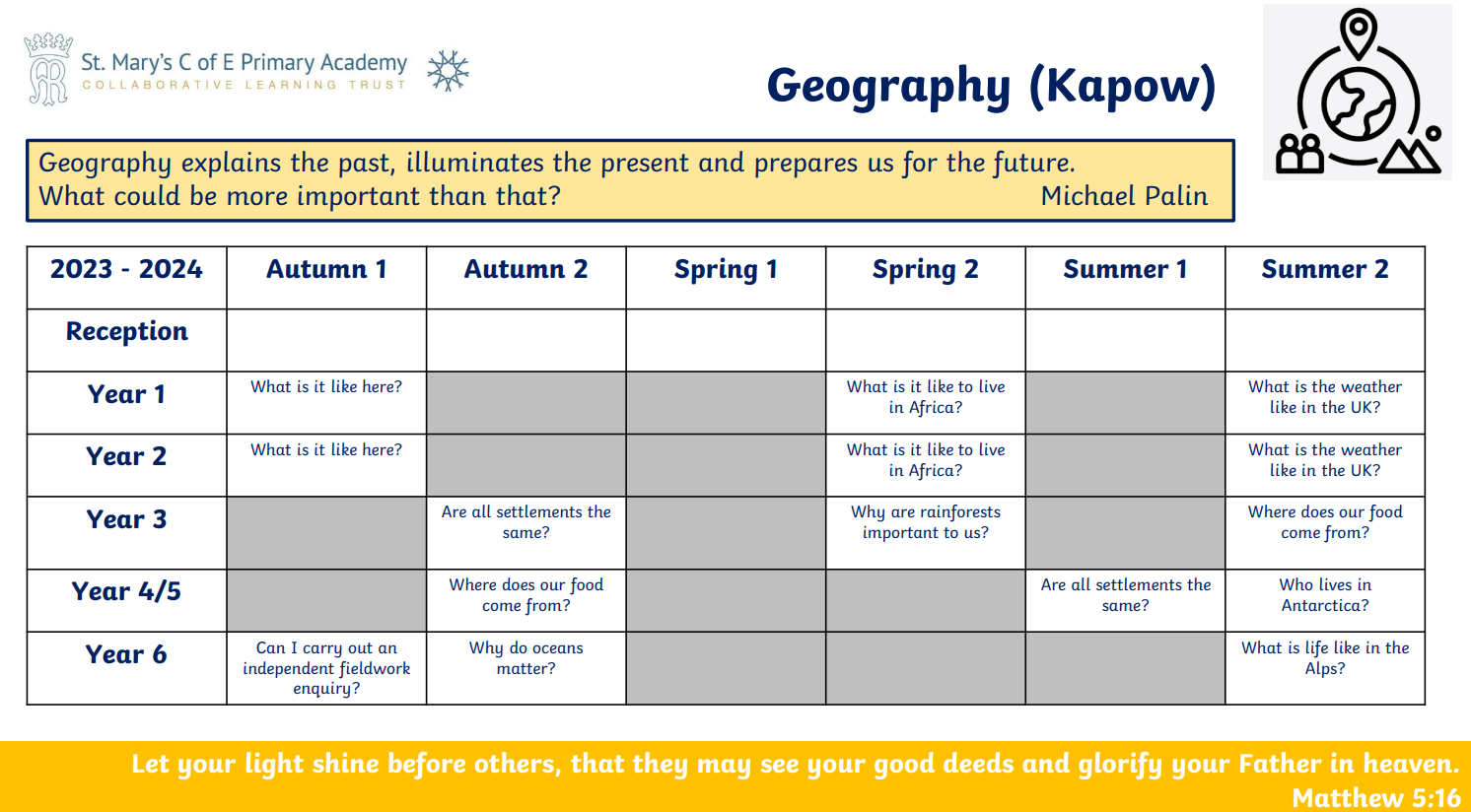Geography
Subject Leader: Mrs L Atkinson.
INTENT
At St. Mary's C of E Primary Academy we want all our children in Geography to:
Learn as much as possible about the human and physical elements of the world we live in through asking perspective questions, developing secure locational and place knowledge and using fieldwork to make geographical learning hands on.
Ignite curiosity by comparing and contrasting different places in our beautiful world.
Show humility by reflecting thoughtfully upon how people’s lives are affected by geographical occurrences around the world and have hope that we can contribute to helping the world through the good deeds we do in our daily lives (recycling, raising awareness of climate change etc.)
IMPLEMENTATION
At St Mary’s C of E Primary Academy, we teach Geography lessons in class with one timetabled lesson per week. This is done for 3 half terms of the year.
Our weekly lessons use Kapow as a teaching resource. Kapow Primary’s Geography scheme of work aims to inspire pupils to become curious and explorative thinkers with a diverse knowledge of the world; in other words, to think like a geographer. We want pupils to develop the confidence to question and observe places, measure and record necessary data in various ways, and analyse and present their findings. Through our scheme of work, we aim to build an awareness of how Geography shapes our lives at multiple scales and over time. We hope to encourage pupils to become resourceful, active citizens who will have the skills to contribute to and improve the world around them.
Implementation
The National curriculum organises the Geography attainment targets under four subheadings or
strands:
• Locational knowledge
• Place knowledge
• Human and physical geography
• Geographical skills and fieldwork
Kapow Primary’s Geography scheme has a clear progression of skills and knowledge within these four strands across each year group. Our Progression of skills and knowledge shows the skills taught within each year group and how these develop to ensure that attainment targets are securely met by the end of each key stage. Geographical key concepts are woven across all units rather than being taught discretely as seen in the Progression of key geographical concepts.
The Kapow Primary scheme is a spiral curriculum, with essential knowledge and skills revisited with increasing complexity, allowing pupils to revise and build on their previous learning. Locational knowledge, in particular, will be reviewed in each unit to coincide with our belief that this will consolidate children’s understanding of key concepts, such as scale and place, in Geography.
Fieldwork includes smaller opportunities on the school grounds to larger-scale visits to investigate physical and human features. Developing fieldwork skills within the school environment and revisiting them in multiple units enables pupils to consolidate their understanding of various methods. It also gives children the confidence to evaluate methodologies without always having to leave the school grounds and do so within the confines of a familiar place. This makes fieldwork
regular and accessible while giving children a thorough understanding of their locality, providing a solid foundation when comparing it with other places.
Lessons incorporate various teaching strategies from independent tasks to paired and group work, including practical hands-on, computer-based and collaborative tasks. This variety means that lessons are engaging and appeal to those with a variety of learning styles. Each lesson provides guidance for teachers on how to adapt their teaching to ensure that all pupils can access learning,
and opportunities to stretch pupils’ learning are also available if required.
Outline of our Scheme of Work
.
Long Term Plan:

Assessment
For each Kapow unit there is a specially designed pre and post-unit assessment activity. We will conducted these twice: this first determines the baseline; it's then repeated at the end of the unit, so that we can monitor children’s progress and identify areas for further development. From these assessments, both children and teachers will be able to see the progress that has been made over the course of each half-termly unit of lesson plans.
Inclusion
Our curriculum is accessible for all, with support for pupils with SEND and opportunities to challenge the more able. Kapow provides strategies to support pupils with SEND and ways to challenge more able learners. Teachers will make adaptations to work for children with SEND.
IMPACT
An enquiry-based approach to learning will allow teachers to assess children against the National curriculum expectations for Geography. The impact of Kapow Primary’s scheme can be constantly monitored through both formative and summative assessment opportunities.
Each lesson includes guidance to support teachers in assessing pupils against the learning objectives. Furthermore, each unit has a unit quiz and knowledge catcher, which can be used at the start or end of the unit to assess children’s understanding. Opportunities for children to present their findings using their geographical skills will also form part of the assessment process in each unit.
After implementing Kapow Primary Geography, pupils should leave school equipped with a range of skills and knowledge to enable them to study Geography with confidence at Key stage 3. We hope to shape children into curious and inspired geographers with respect and appreciation for the world around them alongside an understanding of the interconnection between the human and the physical.
The expected impact of following the Kapow Primary Geography scheme of work is that children will:
● Compare and contrast human and physical features to describe and understand similarities and differences between various places in the UK, Europe and the Americas.
● Name, locate and understand where and why the physical elements of our world are located and how they interact, including processes over time relating to climate, biomes, natural disasters and the water cycle.
● Understand how humans use the land for economic and trading purposes, including how the distribution of natural resources has shaped this.
● Develop an appreciation for how humans are impacted by and have evolved around the physical geography surrounding them and how humans have had an impact on the environment, both positive and negative.
● Develop a sense of location and place around the UK and some areas of the wider world using the eight-points of a compass, four and six-figure grid references, symbols and keys on maps, globes, atlases, aerial photographs and digital mapping.
● Include a paragraph that explains your assessment models (AfL), tracking and evidencing progress processes in Geography.
● Identify and understand how various elements of our globe create positioning, including latitude, longitude, the hemispheres, the tropics and how time zones work, including night and day.
● Present and answer their own geographical enquiries using planned and specifically chosen methodologies, collected data and digital technologies.
● Meet the ‘Understanding the World’ Early Learning Goals at the end of EYFS, and the end of key stage expectations outlined in the National curriculum for Geography by the end of Year 2 and Year 6.
We want the children to have thoroughly enjoyed learning about geography, therefore encouraging them to undertake new life experiences now and in the future. Our geography curriculum is high quality, well thought out and is planned to demonstrate progression. If children are keeping up with the curriculum, they are deemed to be making good or better progress.
